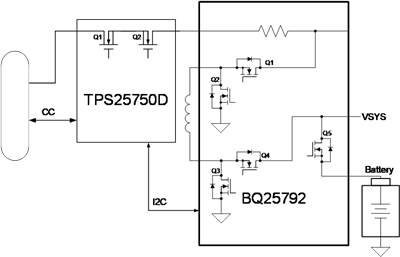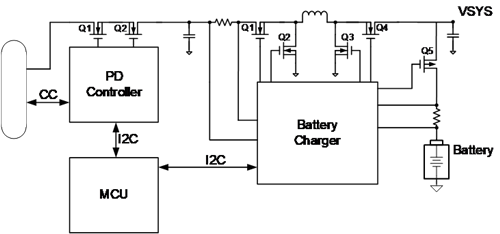-
Adding USB Type-C® with USB Power Delivery to Battery-powered Applications
Adding USB Type-C® with USB Power Delivery to Battery-powered Applications
Eric Beljaars
Upal Patel co-authored this article.
A USB Type-C® port with USB Power Delivery (PD) is becoming the standard port for charging single- and multi-cell battery-powered devices. Applications such as wireless speakers, power banks and power tools have been transitioning from proprietary charging ports, legacy USB ports and barrel-jack ports to a standardized USB PD port. USB PD offers a universal alternative for fast and convenient charging, removing the need for users to carry around several adapters or cables with them – helping design engineers create smaller applications with faster charging and fewer components.
As these applications become more feature-rich, compact and power-hungry, it becomes necessary to deliver more power in a smaller solution size. Concurrently, consumers are beginning to expect USB Type-C on their new devices. But implementing a USB PD port has historically been quite challenging for product developers.
Simplifying your design challenge
In the past, adding a USB PD port required a very in-depth understanding of USB specifications and a large firmware and hardware development effort. Several different components need to work together in order to facilitate USB PD support. The two main integrated circuits (ICs) required to complete a USB PD port for charging applications are the USB PD controller IC and battery-charger IC. These ICs typically operate independently of one another and cannot work in a system without a lot of involvement from an external Microcontroller (MCU).
This limitation also then requires MCU firmware development in order to communicate events happening on the USB PD port to the battery-charger IC. For example, once the USB PD controller IC negotiates a new voltage and current on the USB Type-C port (or a new power contract), the microcontroller needs to read this information back from the USB PD controller and then update the battery chargers’ charge current and charge voltage based on what’s connected to the USB PD port. Additionally, sourcing power out of the USB PD port to charge external devices requires additional communication between the USB PD controller, MCU and battery charger.
Programming the MCU to interface between the USB PD controller and battery charger is usually not the only firmware development required when adding USB PD. Typical PD controller ICs require some form of firmware development to configure the PD controller behavior itself, such as compiling some code or scripting functions together. Configuring the USB PD controller is necessary in order to ensure that the settings on the PD controller meet your system requirements, including which voltages and currents the system can sink and which ones it can source.
Designing with TI controllers and chargers
To help simplify the design of a USB PD port for battery-powered applications up to 45 W, the TPS25750 USB PD controller adds I2C host support to directly control the BQ25792 battery charger without any intervention from an external MCU. The TPS25750 USB PD controller will automatically update the charging parameters of the BQ25792 over I2C based on the power negotiation over the USB PD port. Thus, the external MCU is now unnecessary, and you don’t need to develop firmware to add a USB PD port to battery-powered applications.
Configuring USB PD port behavior with the TPS25750’s web-based graphical user interface (GUI) entails answering a few multiple-choice questions about what your USB PD port needs to support – no complex scripting, code compiling or firmware development is required. This doesn’t just reduce bill-of-materials costs; it allows you to add USB PD without possessing in-depth expertise about the technology.
The TPS25750 and BQ25792 integrate all of the power paths required for the battery charger and USB PD controller. Figure 1 highlights how these devices simplify the implementation of a USB PD port for battery-powered systems up to 45 W. When using these two ICs together, the USB PD port will be able to support bidirectional power to both source and sink power, thus enabling the system to charge or be charged from the USB PD port when attached to an external device like a laptop, smartphone, headphones or AC adapter.
In addition to these system implementation benefits, the TPS25750D and BQ25792 integrate all of the system’s field-effect transistors (FETs) and remove the need for an external MCU, enabling you to achieve a very small solution size. When compared to an MCU-based nonintegrated USB PD battery-charging implementation, the typical system solution size is around 150 mm2. When using the TPS2570 and BQ25792, it is possible to achieve a system solution size around 55 mm2.
 Figure 1 TPS25750D and BQ25792 USB PD Battery-charger Implementation
Figure 1 TPS25750D and BQ25792 USB PD Battery-charger ImplementationFigure 2 highlights an MCU-based USB PD controller and a battery charger with external FETs for applications requiring high-power charging and system power typically greater than 45 W. For applications greater than 45 W, consider pairing the TPS25750 controller with the BQ25731 charger.
 Figure 2 MCU-based Nonintegrated Solution
Figure 2 MCU-based Nonintegrated SolutionTable 1 compares USB PD charging for integrated and nonintegrated MCU-based solutions.
| USB PD battery-charger implementation up to 45 W | MCU-based nonintegrated USB PD battery-charger implementation | |
|---|---|---|
| External MCU | Not required; the TPS25750 is the I2C host controller for the battery charger | Required; the USB PD controller and battery charger operate independently |
| Firmware development | Not required; the system is configurable through a Q&A GUI | Required; necessary to interface with the USB PD controller and battery charger through the MCU |
| System power paths | All system power paths are integrated in the USB PD controller and battery charger | External FETs are necessary to complete the solution |
| Solution size | Approximately 55 mm2 | Approximately 150 mm2 |
The trend toward using USB PD for charging has recently become more urgent, with regulations pushing for universal chargers. Updating your system to charge from USB PD is now easier than ever with the TPS25750 and BQ25792, enabling you to move to the latest universal charging connector while not compromising on solution size.
Additional Resources:
- Read the technical article, "Universal and fast charging - a future trend for battery-powered applications."
- Discover the reference design, "Integrated USB Type-C® power delivery (PD) and charging reference design for 2-4 cell batteries."
- Watch the video, "No firmware development required: New USB Type-C and USB Power Delivery GUI."
IMPORTANT NOTICE AND DISCLAIMER
TI PROVIDES TECHNICAL AND RELIABILITY DATA (INCLUDING DATASHEETS), DESIGN RESOURCES (INCLUDING REFERENCE DESIGNS), APPLICATION OR OTHER DESIGN ADVICE, WEB TOOLS, SAFETY INFORMATION, AND OTHER RESOURCES “AS IS” AND WITH ALL FAULTS, AND DISCLAIMS ALL WARRANTIES, EXPRESS AND IMPLIED, INCLUDING WITHOUT LIMITATION ANY IMPLIED WARRANTIES OF MERCHANTABILITY, FITNESS FOR A PARTICULAR PURPOSE OR NON-INFRINGEMENT OF THIRD PARTY INTELLECTUAL PROPERTY RIGHTS.
These resources are intended for skilled developers designing with TI products. You are solely responsible for (1) selecting the appropriate TI products for your application, (2) designing, validating and testing your application, and (3) ensuring your application meets applicable standards, and any other safety, security, or other requirements. These resources are subject to change without notice. TI grants you permission to use these resources only for development of an application that uses the TI products described in the resource. Other reproduction and display of these resources is prohibited. No license is granted to any other TI intellectual property right or to any third party intellectual property right. TI disclaims responsibility for, and you will fully indemnify TI and its representatives against, any claims, damages, costs, losses, and liabilities arising out of your use of these resources.
TI’s products are provided subject to TI’s Terms of Sale (www.ti.com/legal/termsofsale.html) or other applicable terms available either on ti.com or provided in conjunction with such TI products. TI’s provision of these resources does not expand or otherwise alter TI’s applicable warranties or warranty disclaimers for TI products.
Mailing Address: Texas Instruments, Post Office Box 655303, Dallas, Texas 75265
Copyright © 2023, Texas Instruments Incorporated